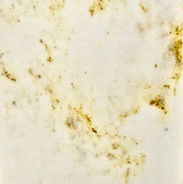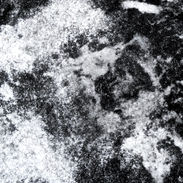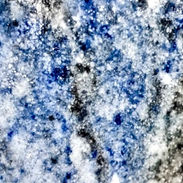
The Material - Marbled Salts
"In ancient times salt was rare and costly.
Yet, since the industrial revolution, it has become so cheap and easily available that we no longer recognize its value. Marbled Salts reinvents sea salt in a sustainable design material. By using its unique physical properties and mixing it with tree resin, Marbled Salts results in a white self-binding composite.
Herein the material draws a contradictory parallel between the flexible versatility of salt and the physical language of heavy and solid rock.
Marbled salts also aim to invite a discussion on the concept of value – essentially a social construct − and the costs the finished product implies. ''

What is the material made of?
Marbled salts are a mineral composite made of 90% sea salt and natural binders.
The resulting powder is colored with pigments, humidified, and molded before being dried slowly at a low temperature.
Whenever the object is fully dry several layers of eco-resin are applied to protect the material from early degrading such as scratches, atmospheric humidity, UV, etc.
The resin shell and the last polishing touch gives its
« real stone » feeling.
Is it ecological?
Marbled salts are 95 to 80% natural and organic depending on the thickness of the object and the desired finish. We use an eco epoxy to protect the material and we are still searching for cleaner and more environmentally friendly varnishing options. To this, it is important to add that all materials are locally sourced (UE) and that the transformation process requires very little energy. The overall carbon footprint is therefore very low.
Is it recyclable?
The material is fully recyclable before the coating, this is why its manufacturing process causes very minimal waste.
Is it sustainable timewise?
The project was initiated in 2016 and presented to the public in 2017. Therefore the oldest pieces are only a couple of years old... but they are doing well! You will find more information and instructions on the topic in the marbled salts caring pdf.
Is it sensitive to stains and scratches?
The resistance of the surface highly depends on the finish. The more natural the look, the more sensitive the material.
Is it suited for outdoor use?
At Marbled Salts Studio, we have managed to develop special treatments for extremely humid and rough environments.
Do not hesitate to ask for a custom quote here.
What are the limits of the material?
They are virtually no limits to the material’s shape, size, textures, and colors. All parameters rely on the size and power of our infrastructures and machines, which we improve and extend one project after another.
Why salt anyway?
Abundance and ecology
Sea salt is one of the most available resources since it is present in all the oceans around the planet. The collecting techniques of sea salt by drying it outdoor in salt flats are known from all cultures around the world since the early ages of human society.
and require a very small amount of energy. Moreover sea salt (sodium chloride) follows water cycles and therefore is naturally recycled and cleaned.
Salt and global warming
Sea salt will become increasingly abundant and even an undesirable substance in places of the world where global warming provokes an unbalanced climate. Water evaporation and therefore desertification appears in regions where lakes and rivers are slowly disappearing. On the other hand, the rise of the sea level due to iceberg melting will (and is already) result(ing) in the implementation of water desalination centers in rich countries such as Saudi Arabia or the state of California. Because of its growing abundance, the cost of sea salt didn’t stop decreasing over the last two centuries, as it was also gradually replaced in different types of industries.
Also just ... cheap
This abundance combined with low pricing makes it an incredibly affordable material.


The Project
This six month research resulted in an imaculated organic composite made from natural gum and salt, opening as many possibilities as a blank page.
From Marbled Salts were born surfaces of man made granite, onyx, marble like composites. The material research conducted explored the relation between filler and binder as well as mixing techniques in order to grasp their influence on patterns ; and opened a thinking path on visualizing man made materials from natural ones.

















